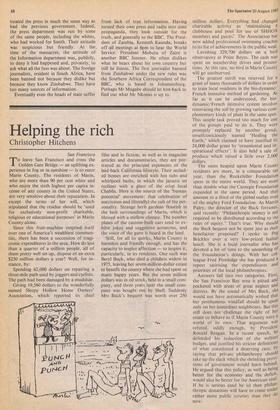Helping the rich
Christopher Hitchens
San Francisco 'To leave San Francisco and cross the
Golden Gate Bridge — an uplifting ex- perience in fog or in sunshine — is to enter Marin County. The residents of Marin, who are more than 90 per cent white and who enjoy the sixth highest per capita in- come of any county in the United States, are very sensitive about their reputation. In except the terms of her will, which stipulated that the residue should be 'used for exclusively non-profit charitable, religious or educational purposes' in Marin County alone.
Since this fruit-machine emptied itself over one of America's wealthiest commun- ties, there has been a succession of tragi- comic expenditures in the area. How do less than a quarter of a million people, all of them pretty well set-up, dispose of an extra $250 million dollars a year? Well, for in- stance, by: Spending 62,000 dollars on repairing a three-mile path used by joggers and cyclists. The path had been damaged by a mudslide, Giving 19,560 dollars to the wonderfully named Sleepy Hollow Home Owners' Association, which reported its chief film and in fiction, as well as in magazine articles and documentaries, they are por- trayed as the principal exponents of the laid-back California lifestyle. Their seclud- ed homes are enriched with hot tubs and whirlpool baths, in which the jacuzzi set reclines with a glass of the crisp local Chablis. Here is, the source of the 'human potential' movement: that celebration of narcissism and (literally) the cult of the per- sonality. Strange herb gardens flourish in the lush surroundings of Marin, which is blessed with a mellow climate. The number plates of the custom-built cars tend to ex- hibit jokey and suggestive acronyms, and the voice of the guru is heard in the land.
Still, for all its quirks, Marin County is harmless and friendly enough, and has the capacity to inspire affection — to inspire it, particularly, in its residents. One such was Beryl Buck, who died a childless widow in 1975, leaving her seven-million-dollar estate to benefit the county where she had spent so many happy years. But the seven million dollars was in oil stock, held in a small com- pany, and three years later the small com- pany was bought out by Shell. Suddenly Mrs Back's bequest was worth over 250 million dollars. Everything had changed charitable activity as 'maintaining a clubhouse and pool for use of SHHOA members and guests'. The Association has now added professional swimming coaches to its list of achievements in the public weal.
avishing 329,700 dollars on a bird observatory at Point Reyes. The cash was spent on membership drives and promo- tions. At this rate, no bird in Marin County will go unobserved.
The greatest mirth was reserved for a grant of many thousands of dollars in order to train local residents in the bio-dynamic/ French intensive method of gardening. As far as it can be understood, the bio- dynamic/French intensive system involves renovating the soil by growing various com- plementary kinds of plant in the same spot. This simple task proved too much for one of the groups paid to do it. They were promptly replaced by another grout), unselfconsciously named 'Healing the Earth,' which claimed to have justified its 24,000 dollar grant by 'ornaniental and in- spirational effects': It also held a sale of produce which raised a little over 2,000 dollars.
The sums heaped upon Marin CountY residents are more, in a comparable tag year, than the Rockefeller Foundation spent in the entire world. They are more than double what the Carnegie Foundation expended in the same period. And they amount to a third of the global outlay even of the mighty Ford Foundation. As Martin Paley, the director of the Buck fortunes, said recently: 'Philanthropic money is not required to be distributed according to the rules of equity.' That's true. Why should the Buck bequest not be spent just as their benefactor proposed? I spoke to Peg Brickley over a very low-priced Italian lunch. She is a local journalist who has devoted a lot of time to the unearthing of the Foundation's doings. With her col- league Fred Powledge she has produced a report satirising the expenditures and priorities of the local philanthropists.
Answers fall into two categories. First, the San Francisco Bay area is pitted and pocketed with areas of great neglect and distress. By the sound of Mrs Buck, she would not have automatically wished that her posthumous windfall should be spent only on her immediate neighbours. But this still does not challenge tho right of her estate to behave as if Marin County were a world of its own. That argument was refuted, oddly enough, by President Ronald Reagan. In a recent speech, he defended his reduction of the welfare budget, and justified his stricter definitions of what constituted a deserving case, by saying that private philanthropy should take up the stack which the shrinking provi" sions of government would leave behind. He argued that this policy, as well as being better for the economy and the deficit, would also be better for the American soul. If he is serious (and he is) then philan- thropic donations will have to come under rather more public scrutiny than they do now.


































 Previous page
Previous page